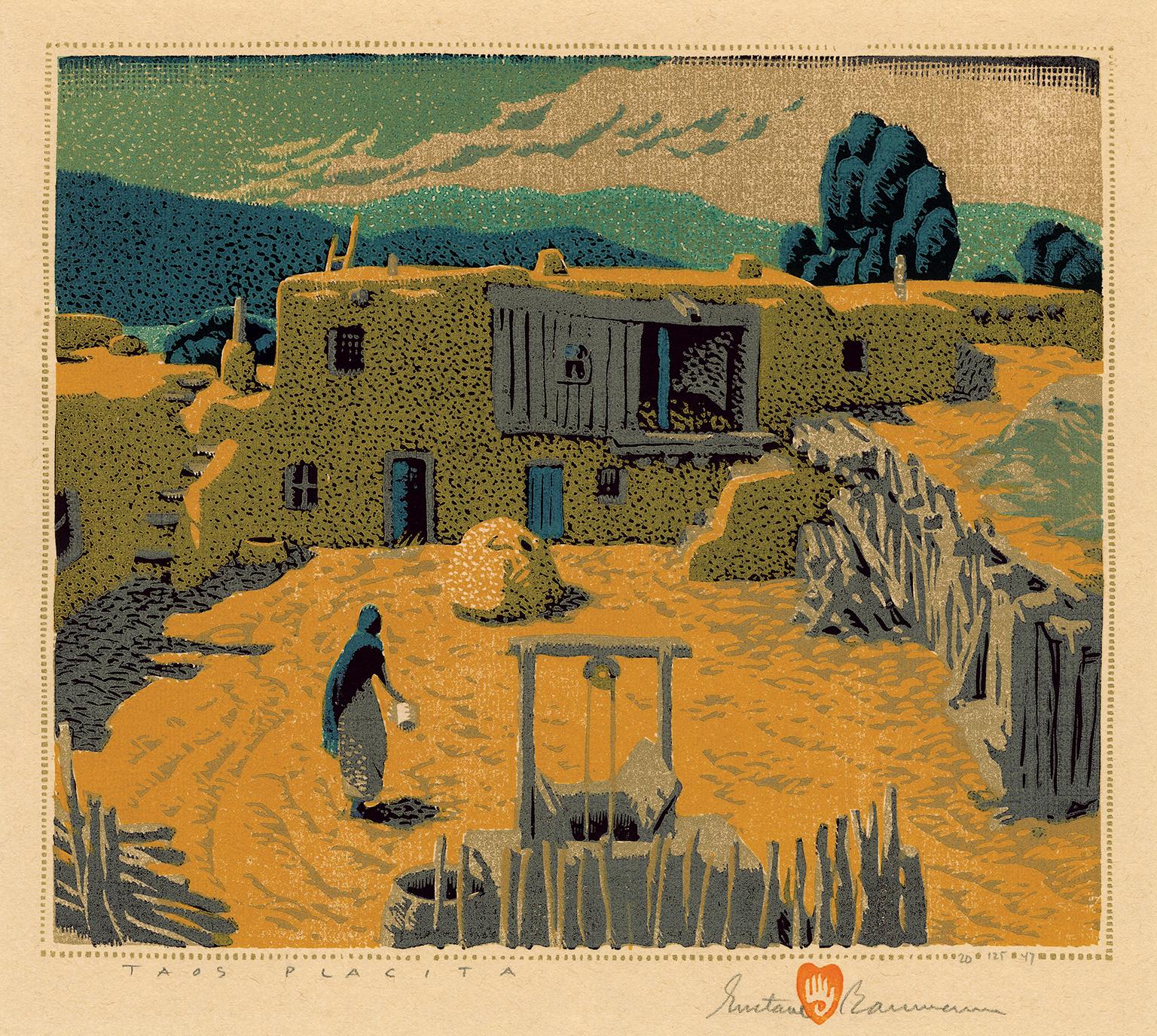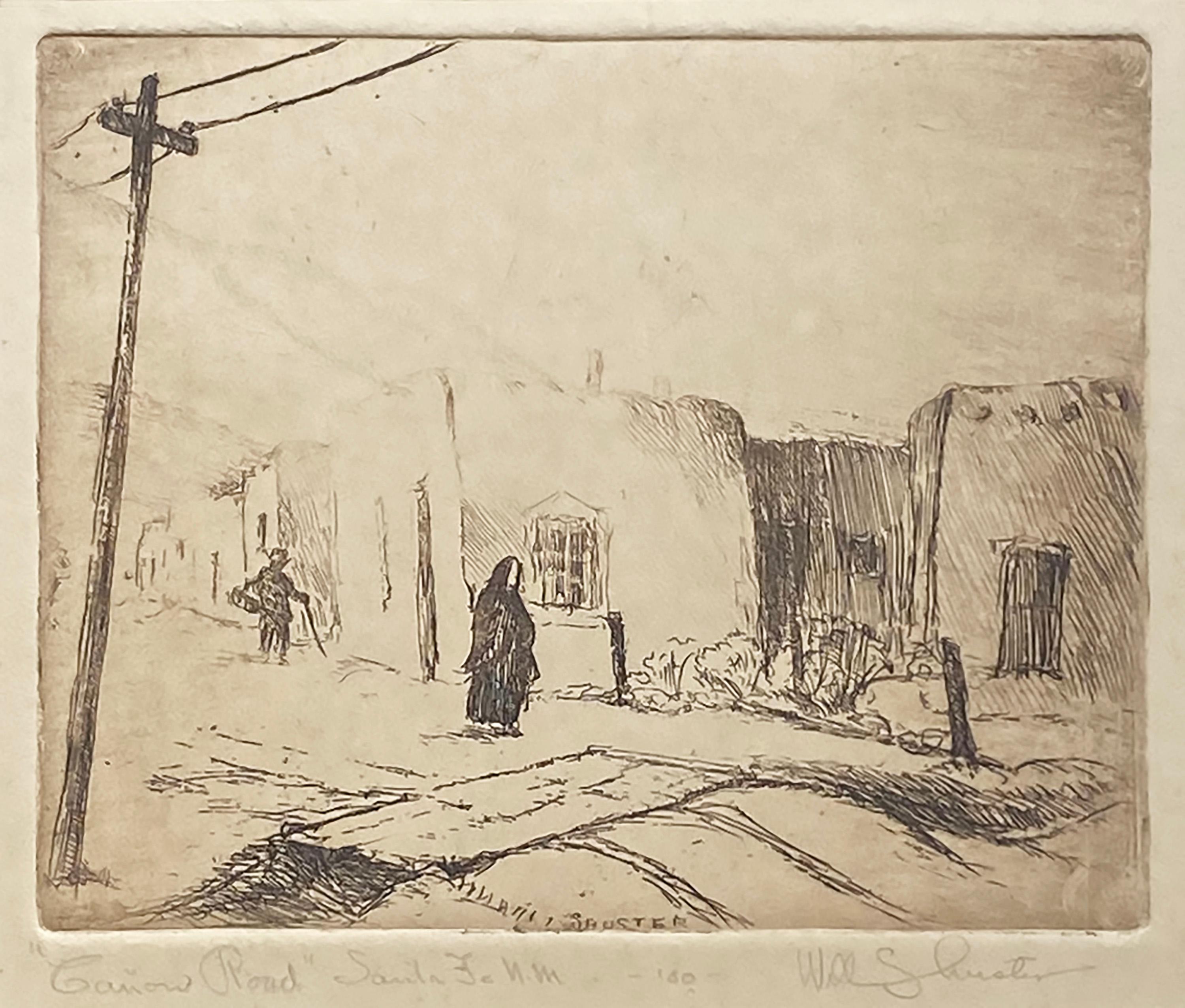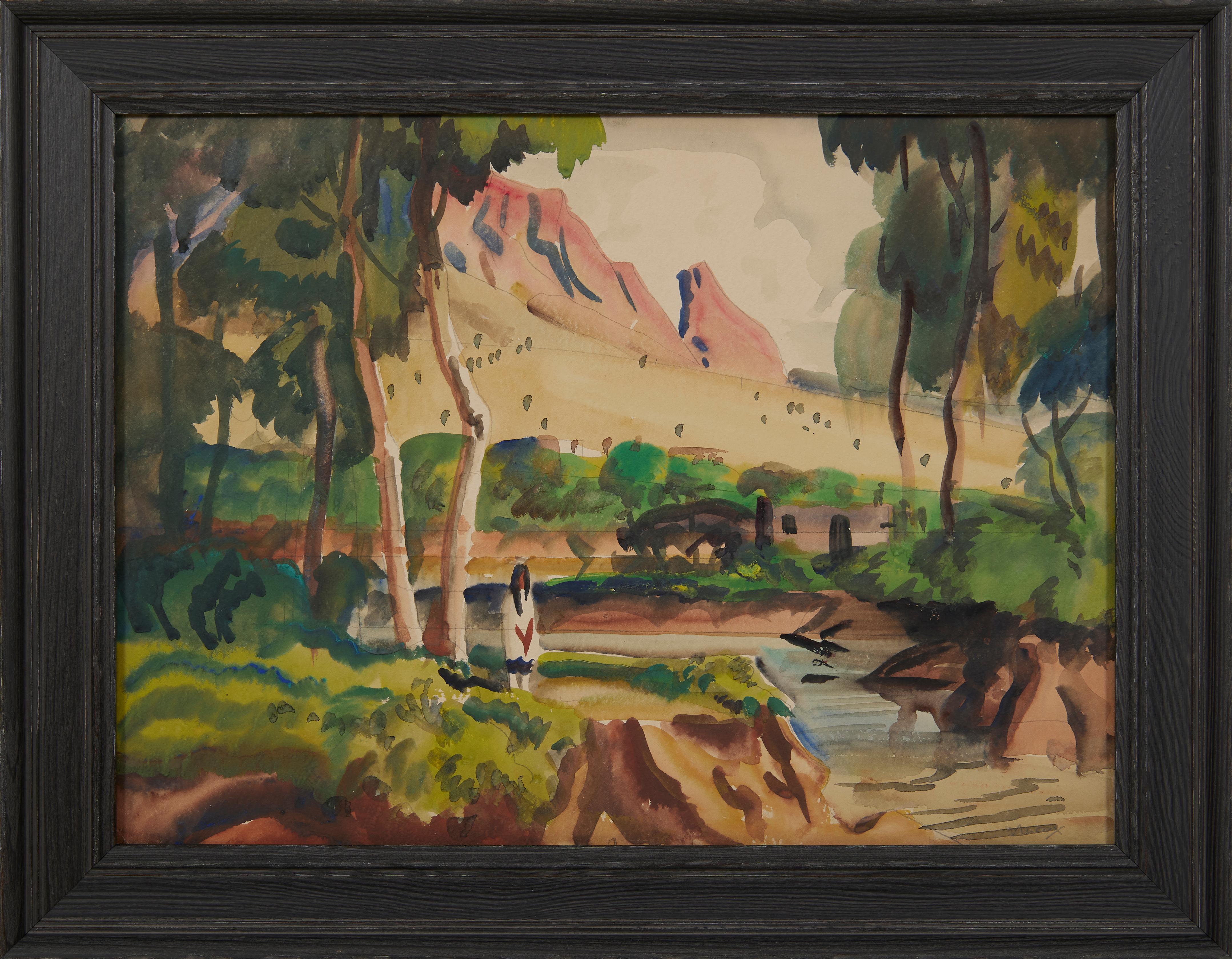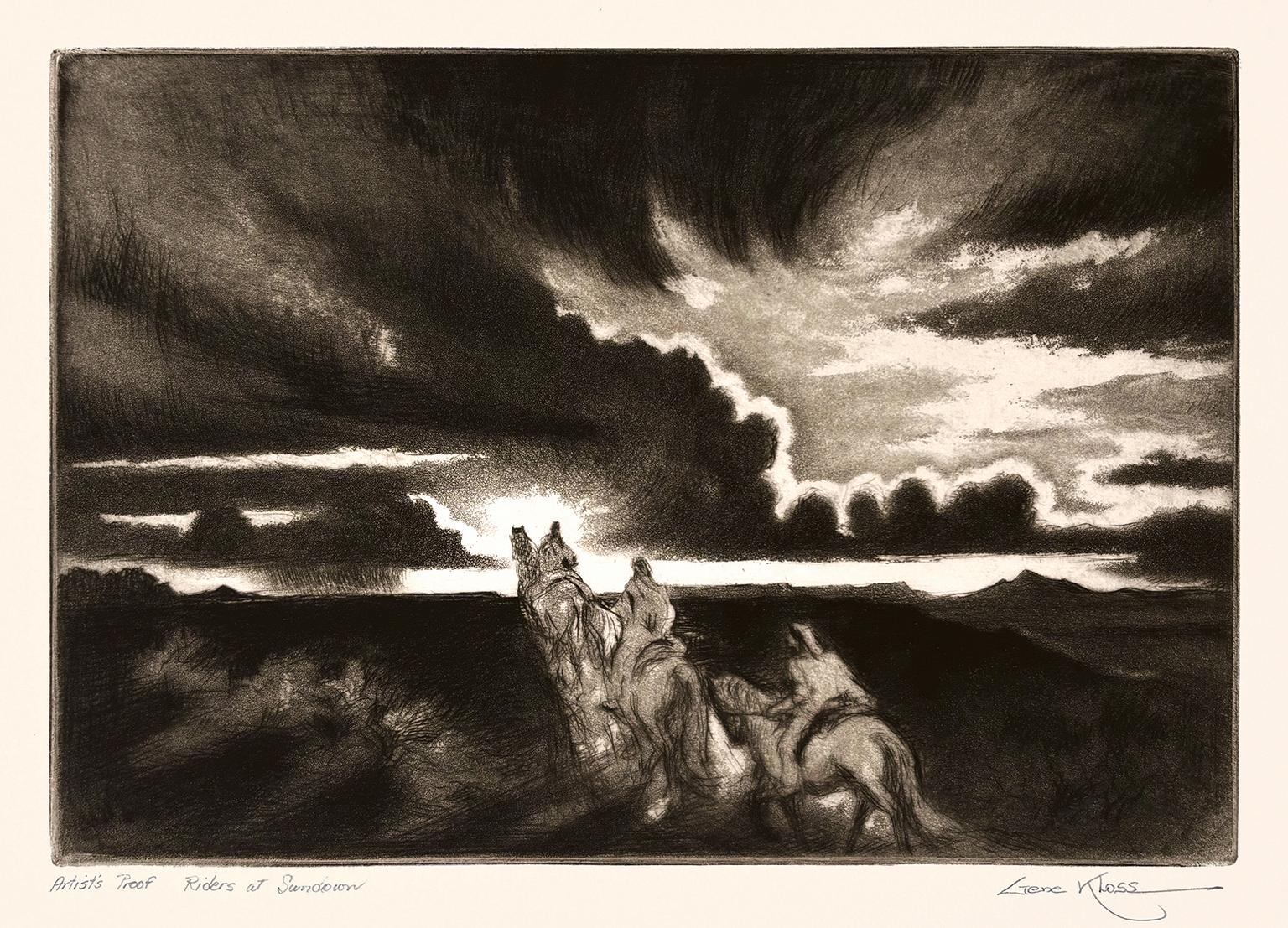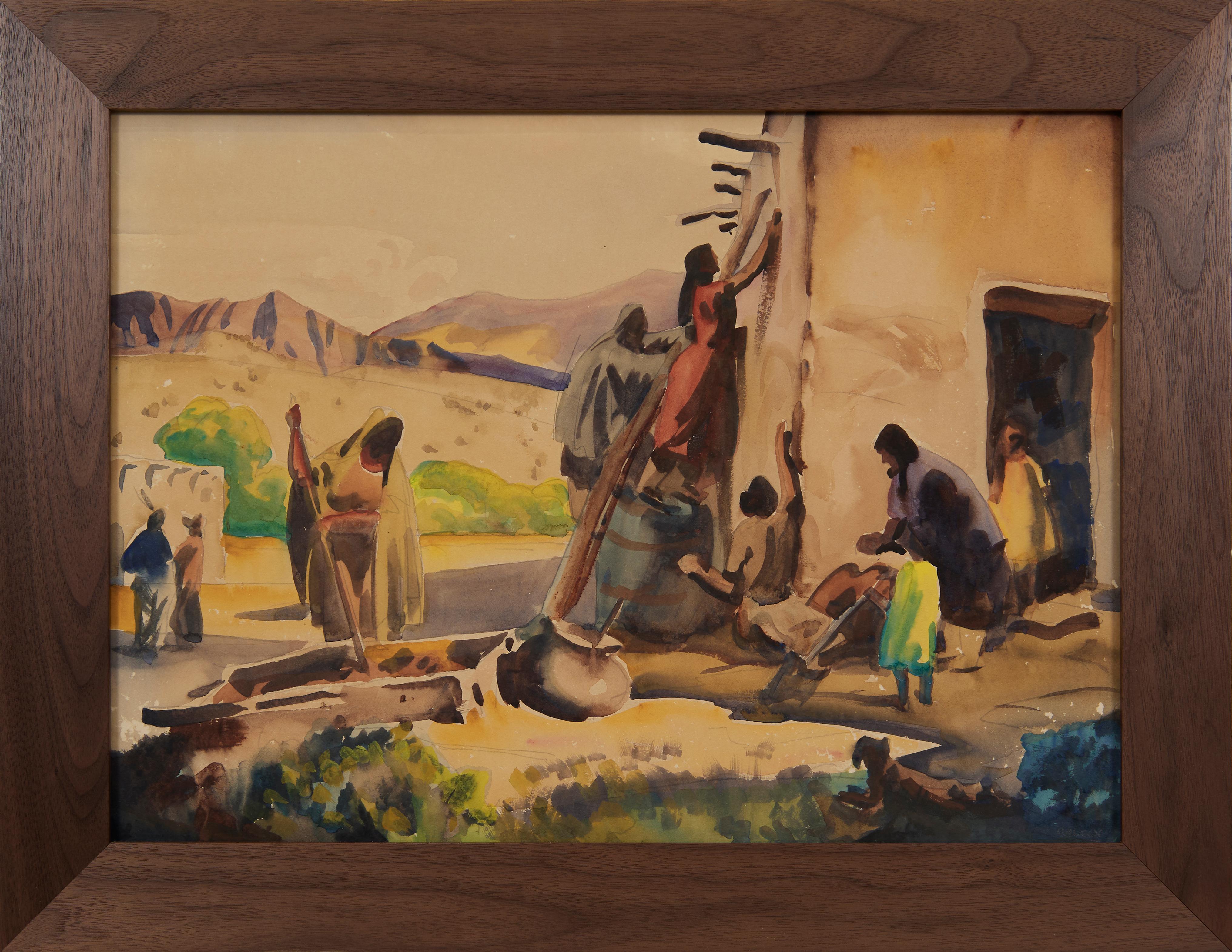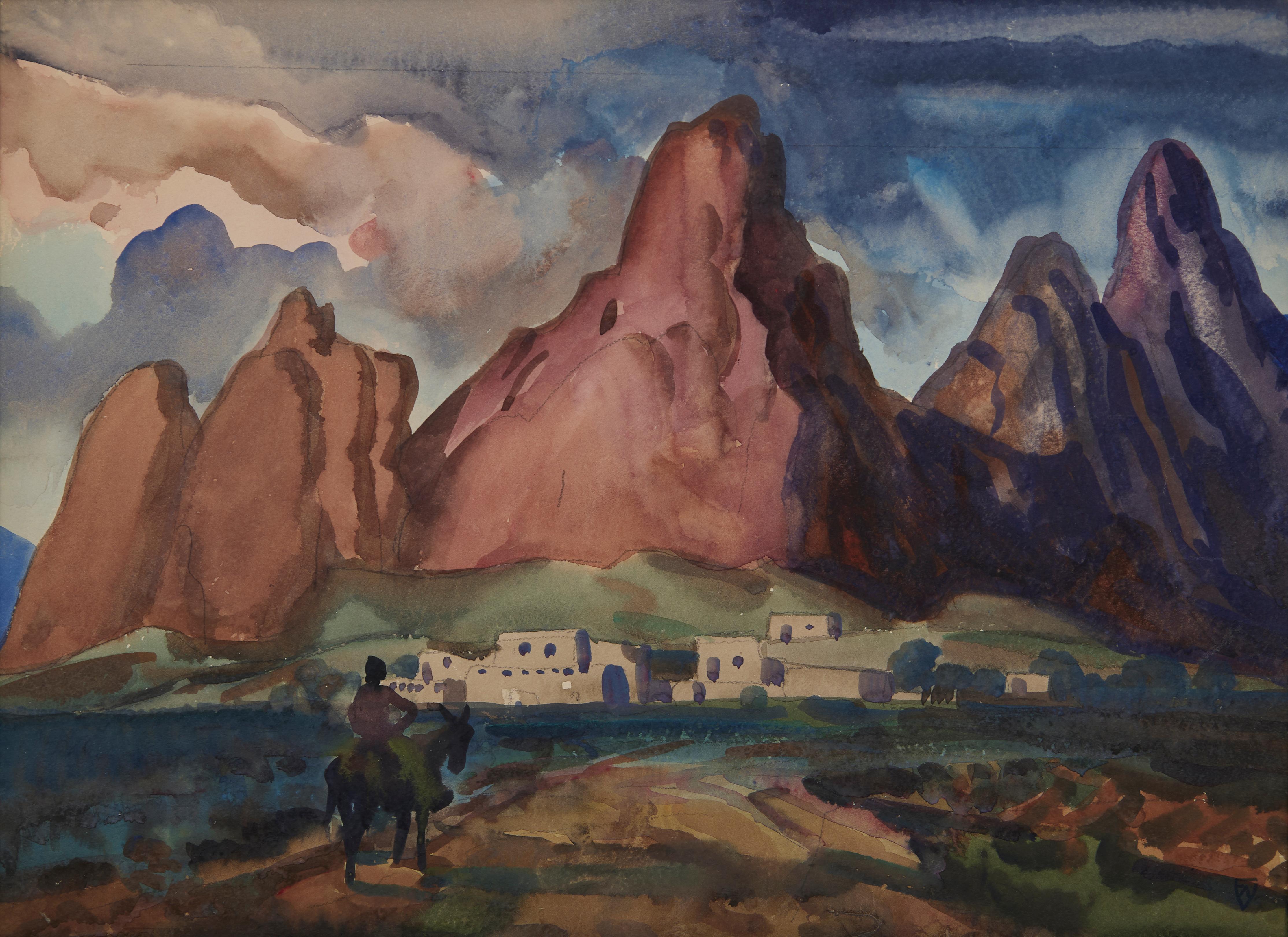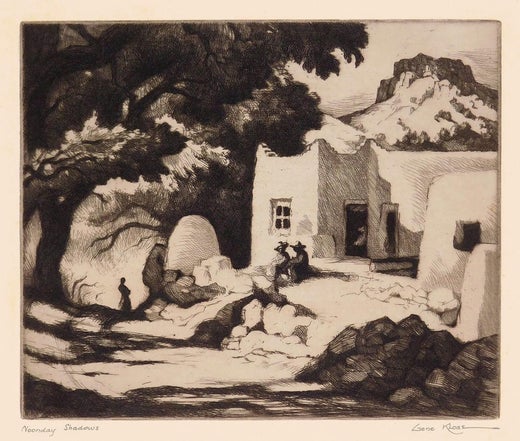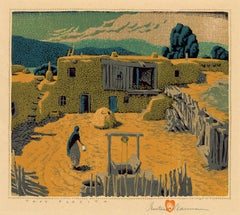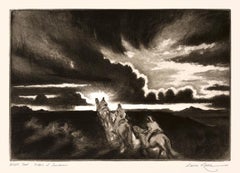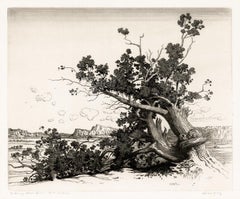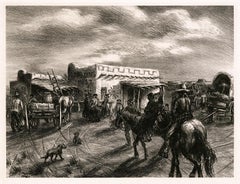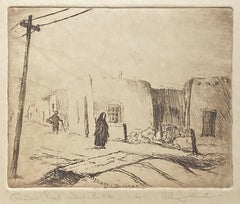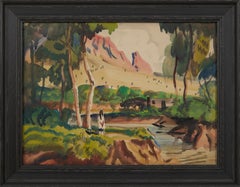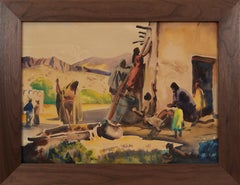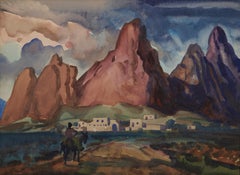Items Similar to 'Noonday Shadows' — Mid-Century Southwest Regionalism
Want more images or videos?
Request additional images or videos from the seller
1 of 3
Gene Kloss'Noonday Shadows' — Mid-Century Southwest Regionalism1953
1953
$1,800
£1,377.81
€1,581.51
CA$2,571.73
A$2,822.09
CHF 1,461.16
MX$33,782.68
NOK 18,331.75
SEK 17,246.65
DKK 11,813.19
About the Item
'Noonday Shadows', etching and drypoint, edition 75, 1941, Kloss 376. Signed, and titled in pencil. A superb, richly inked impression, in warm black ink, on buff wove paper, in excellent condition. The full sheet with margins (7/8 to 1 1/8 inches); the sheet edges trimmed unevenly, as was the artist's custom.
Image size 7 x 8 1/2 inches (178 x 216 mm); sheet size 9 1/8 x 10 1/8 inches (232 x 257 mm).
Impressions of this work are in the collections of the Allentown Art Museum, Fine Arts Museums of San Francisco, and The Harwood Museum of Art.
ABOUT THE ARTIST
“...a work of art is not complete until it is shared with someone."
—Gene Kloss
Gene Kloss, born Alice Geneva Glasier in Oakland, California, was one of the most prominent American printmakers of the 20th century. Renowned for her evocative etchings and paintings of the American Southwest, Kloss captured the spiritual and cultural essence of New Mexico’s landscapes and Native American ceremonies with striking sensitivity and technical mastery.
Kloss developed an early interest in art and studied at the University of California, Berkeley, where she earned her B.A. in 1924. She later studied at the California School of Fine Arts (now San Francisco Art Institute). In 1925, she married poet and composer Phillips Kloss, and soon after, the couple began spending summers in Taos, New Mexico—a region that became central to her artistic identity.
Her first major one-person exhibition, which included almost 100 etchings, oils, watercolors, block prints and monotypes, at the Berkeley League of Fine Arts in March 1926 received popular and critical acclaim and marked the start of a career which included over 70 exhibitions in the Bay Area. From 1933 to 1944 Kloss was the sole etcher employed by the Public Works of Art Project. Her series of nine New Mexico scenes from that period were reproduced and distributed to public schools across the state. She also created watercolors and oil paintings for the WPA. In 1935, she was one of three Taos artists who represented New Mexico at a Paris exhibition called "Three Centuries of Art in the United States".
Drawn to the dramatic light, rugged terrain, and deep cultural heritage of the Southwest, Kloss found endless inspiration in the landscapes, pueblos, and Native American rituals of New Mexico. She eventually settled permanently in Taos in 1960 and was closely associated with the Taos art colony.
Kloss worked primarily in intaglio printmaking, producing more than 600 etchings during her career. Remarkably, Kloss pulled each impression of every edition herself, never relinquishing her artistic power and impeccable standards.
Her work is particularly noted for its rich tonal range, finely observed detail, and emotional depth. She frequently depicted scenes of Pueblo life, especially ceremonial dances, which she witnessed with great respect and often sketched from memory out of deference to their sacred nature.
Kloss’ art was widely exhibited across the United States, and she received numerous honors, including the Eyre Gold Medal, Pennsylvania Academy of Fine Arts 1936; Associate Membership Award, California Society of Etchers 1934; Henry B. Shope Prize, Society of American Etchers 1951; First Prize, Chicago Society of Etchers 1952; Honorable Mention, Society of American Graphic Artists 1953; Purchase Award, Library of Congress 1953; Honorable Mention, Chicago Society of Etchers 1955; Honorable Mention, Philadelphia Sketch Club 1957; Fower Prize 1960 and Purchase Prize 1961, Print Club of Albany; Anonymous Prize, National Academy of Design 1961; Honorable Mention, Museum of New Mexico 1964. Kloss was the first woman admitted to the National Academy of Design in 1950, the greatest honor afforded to artists of her generation.
Kloss maintained memberships in many art organizations including, the Albany Print Club, the Society of American Etchers, the Chicago Society of Etchers, the California Society of Etchers, the Carmel Art Association, the Prairie Print Makers, the New Mexico Art League, the Society of American Graphic Artists, and the Philadelphia Watercolor Club.
Kloss remained artistically active well into her later years leaving behind a remarkable legacy of American printmaking and a body of work that continues to evoke the mystique and majesty of the Southwest. Her works are held in major collections, including the Achenbach Foundation for Graphic Arts, Art Institute of Chicago, Dallas Museum of Fine Arts, Fine Arts Museums of San Francisco, Honolulu Museum of Fine Arts, National Gallery of Art, Metropolitan Museum of Art, Museum of New Mexico, New York Public Library, Pennsylvania Academy of Fine Art, Smithsonian Institution Museums, U.S. Library of Congress, and the West Texas Museum.
- Creator:Gene Kloss (1903-1996, American)
- Creation Year:1953
- Dimensions:Height: 7 in (17.78 cm)Width: 8.5 in (21.59 cm)
- Medium:
- Movement & Style:
- Period:
- Condition:
- Gallery Location:Myrtle Beach, SC
- Reference Number:Seller: 1043601stDibs: LU532316674972
Gene Kloss
Gene (Alice Geneva) Kloss is considered one of America’s master printmakers. She was born in Oakland, California and established herself as an artist on the West coast. Kloss was introduced to etching by Perham Nahl while at UC Berkley. She graduated in 1924, and in 1925 married poet Phillips Kloss. In her late twenties, Kloss moved to Taos, New Mexico and began her life’s work of the New Mexican landscape and peoples. It was at this time that she received national acclaim. Her artwork exudes an unmistakable content and style. Enchanted by the architecture, mountainous landscapes and rituals of the inhabitants, Kloss captured the beauty of the Southwest and surrounding areas. Her style was bold yet deftly simple, masterfully expressing the elusive Southwestern light. In 1938, she exhibited in Paris with Ernest Blumenschein, Georgia O’Keeffe, and John Sloan. She was also a member of the National Academy of Design, New York.
About the Seller
5.0
Recognized Seller
These prestigious sellers are industry leaders and represent the highest echelon for item quality and design.
Platinum Seller
Premium sellers with a 4.7+ rating and 24-hour response times
Established in 1995
1stDibs seller since 2016
325 sales on 1stDibs
Typical response time: 1 hour
Associations
International Fine Print Dealers Association
- ShippingRetrieving quote...Shipping from: Myrtle Beach, SC
- Return Policy
Authenticity Guarantee
In the unlikely event there’s an issue with an item’s authenticity, contact us within 1 year for a full refund. DetailsMoney-Back Guarantee
If your item is not as described, is damaged in transit, or does not arrive, contact us within 7 days for a full refund. Details24-Hour Cancellation
You have a 24-hour grace period in which to reconsider your purchase, with no questions asked.Vetted Professional Sellers
Our world-class sellers must adhere to strict standards for service and quality, maintaining the integrity of our listings.Price-Match Guarantee
If you find that a seller listed the same item for a lower price elsewhere, we’ll match it.Trusted Global Delivery
Our best-in-class carrier network provides specialized shipping options worldwide, including custom delivery.More From This Seller
View All'Taos Placita' — American Southwest Regionalist Masterwork
By Gustave Baumann
Located in Myrtle Beach, SC
Gustave Baumann, 'Taos Placita', color woodcut, 1947, edition 125. Baumann 132. Signed, titled, and numbered '20-125' in pencil; with the artist’s Hand-in-Heart chop. A superb, richly-inked impression, with fresh colors, on fibrous oatmeal wove paper; the full sheet with margins (2 to 3 1/8 inches); slight rippling at the left sheet edge, in excellent condition. Matted to museum standards, unframed.
Image size 9 5/8 x 11 1/4 inches (244 x 286 mm); sheet size 13 1/4 x 17 inches (337 x 432 mm).
Collections: Harwood Museum of Art, New Mexico Museum of Art, Phoenix Art Museum, Scottsdale Art Museum, Wichita Art Museum.
ABOUT THE ARTIST
Gustave Baumann (1881-1971) was a renowned printmaker and a leading figure of the American color woodcut revival whose exquisite craftsmanship and vibrant imagery captured the essence of the Southwest.
"A brilliant printmaker, Baumann brought to the medium a full mastery of the craft of woodworking that he acquired from his father, a German cabinetmaker. This craftsmanship was coupled with a strong artistic training that resulted in the handsome objects we see in the exhibition today. After discovering New Mexico in 1918, Baumann began to explore in his woodblock prints of this period the light. color, and architectural forms of that landscape. His prints of this period are among the most beautiful and poetic images of the American West."
—Lewis I. Sharp, Director, Denver Art Museum
Baumann, the son of a craftsman, immigrated to the United States from Germany with his family when he was ten, settling in Chicago. From 1897 to 1904, he studied in the evenings at the Art Institute of Chicago, working in a commercial printmaking shop during the day. In 1905, he returned to Germany to attend the Kunstwerbe Schule in Munich, where he decided on a career in printmaking. He returned to Chicago in 1906 and worked for a few years as a graphic designer of labels.
Baumann made his first prints in 1909 and exhibited them at the Art Institute of Chicago the following year. In 1910, he moved to the artists’ colony in Nashville, Indiana, where he explored the creative and commercial possibilities of a career as a printmaker. In 1915, he exhibited his color woodcuts at the Panama-Pacific International Exposition in San Francisco, winning the gold medal.
Among Baumann’s ongoing commercial activities was his work for the Packard Motor Car Company from 1914 to 1920 where he produced designs, illustrations, and color woodcuts until 1923.
In 1919, Baumann’s printmaking work dominated the important exhibition of American color woodcuts at the Detroit Institute of Arts. Twenty-six of his prints were included, far more than the works of any other artist. A set of his blocks, a preparatory drawing, and seven progressive proofs complemented the exhibition. That same year, Baumann worked in New York and, over the summer, in Provincetown, Massachusetts. His airy images of Cape Cod employed soft, pastel colors and occasionally showed the influence of the white-line woodcut technique.
Many of his Chicago artist friends had traveled to the southwest, and Baumann became intrigued by their paintings, souvenirs, and stories of an exotic place named Taos, New Mexico. In the summer of 1918, he spent the summer in Taos sketching and painting before visiting Santa Fe. Paul Walter, the director of the Museum of New Mexico, offered him a studio in the museum's basement. Inspired by the rugged beauty of the Southwest—the vibrant colors and dramatic landscapes of the region became a central theme in his work, influencing his artistic style and subject matter for the remainder of his career. Later in the decade, he traveled to the West Coast and made prints of California landscape.
Baumann's prints became synonymous with the Southwest, capturing the spirit of its place in America's identity with a unique sense of authenticity and reverence. His iconic images of desert vistas, pueblo villages, and indigenous cultures served as visual tributes to the region's rich cultural heritage, earning him a dedicated following among collectors and curators alike.
A true craftsman and artist, Baumann completed every step of the printmaking process himself, cutting each block, mixing the inks, and printing every impression on the handmade paper he selected. His dedication to true craftsmanship and his commitment to preserving the integrity of his artistic vision earned him widespread acclaim and recognition within the art world. About the vibrant colors he produced, Baumann stated, “A knowledge of color needs to be acquired since they don’t all behave the same way when ground or mixed...careful chemistry goes into the making of colors, with meticulous testing for permanence. While complicated formulae evolve new colors, those derived from Earth and metal bases are still the most reliable.”
In the 1930s, Baumann became interested in puppet theater. He designed and carved his own marionettes and established a little traveling company. From 1943 to 1945, the artist carved an altarpiece for the Episcopal Church of the Holy Faith in Santa Fe. In 1952, a retrospective exhibition of his prints was mounted at the New Mexico Museum of Fine Arts. Throughout his prolific career, Baumann executed nearly four hundred color woodcuts.
Baumann’s woodcuts...
Category
1940s American Modern Landscape Prints
Materials
Woodcut
'Riders at Sundown' — Mid-Century Southwest Regionalism
By Gene Kloss
Located in Myrtle Beach, SC
'Riders at Sundown', aquatint and drypoint, edition 75, 1953, Kloss 451. Signed, titled, and annotated 'Artist's Proof' in pencil. A superb, richly-inked, atmospheric impression, in ...
Category
1950s American Modern Landscape Prints
Materials
Drypoint, Aquatint
'Old Cedars' – Early New Mexico Landscape, Southwest Regionalism
By George Elbert Burr
Located in Myrtle Beach, SC
George Elbert Burr, 'Old Cedars – New Mexico', etching, 1920, edition 40, Seeber 218. Signed and annotated '(c) George Elbert Burr Del. et Imp.' in pencil. ...
Category
1920s Realist Landscape Prints
Materials
Etching
'Navajo Trading Post' — Southwest Regionalism, American Indian
By Ira Moskowitz
Located in Myrtle Beach, SC
Ira Moskowitz, 'Navajo Trading Post', lithograph, 1946, edition 30, Czestochowski 161. Signed and dated in the stone, lower left. A fine, richly-inked impression, on cream wove paper, with full margins (1 1/2 to 3 1/8 inches). Pale mat line, otherwise in excellent condition. Matted to museum standards, unframed.
Image size 11 11/16 x 15 1/2 inches (297 x 395 mm); sheet size 16 5/16 x 191/8 inches (414 x 486 mm).
ABOUT THE ARTIST
Ira Moskowitz was born in Galicia, Poland, in 1912, emigrating with his family to New York in 1927. He enrolled at the Art Student's League and studied there from 1928-31. In 1935, Moskowitz traveled to Paris and then lived until 1937 in what is now Israel. He returned to the United States in 1938 to marry artist Anna Barry in New York. The couple soon visited Taos and Santa Fe in New Mexico, returning for extended periods until 1944, when they moved there permanently, staying until 1949. During this especially productive New Mexico period, Moskowitz received a Guggenheim fellowship. His work was inspired by the New Mexico landscape and the state’s three cultures (American Southwest, Native American, and Mexican). He focused on Pueblo and Navajo life, producing an extensive oeuvre of authentic American Indian imagery. He and Anna also visited and sketched across the border in Old Mexico. While in the Southwest, Moskowitz flourished as a printmaker while continuing to produce oils and watercolors. Over 100 of Moskowitz’s works depicting Native American ceremonies were used to illustrate the book American Indian Ceremonial Dances by John Collier, Crown Publishers, New York, 1972.
After leaving the Southwest, printmaking remained an essential medium for the artist while his focus changed to subject matter celebrating Judaic religious life and customs. These works were well received early on, and Moskowitz was content to stay with them the rest of his life. From 1963 until 1966, Moskowitz lived in Paris, returning to New York City in 1967, where he made his permanent home until he died in 2001.
Shortly before his death, Zaplin-Lampert Gallery of Santa Fe staged an exhibition of the artist's works, December 2000 - January 2001. Other one-person shows included the 8th Street Playhouse, New York, 1934; Houston Museum, 1941; and the San Antonio Museum, 1941. The artist’s work was included in exhibitions at the Art Students League, Art Institute of Chicago, Philadelphia Print Club, College Art Association (promotes excellence in scholarship and teaching), and the International Exhibition of Graphic Arts (shown at MOMA, 1955).
Moskowitz’s lithographs of American Indian...
Category
1940s American Modern Landscape Prints
Materials
Lithograph
'Navajo Reservation Landscape' — Southwest Regionalism
By Ira Moskowitz
Located in Myrtle Beach, SC
Ira Moskowitz, 'Navajo Reservation Landscape', lithograph, 1945, edition c. 30. Signed and titled in pencil. Signed and dated in the stone, lower left. A fine, richly-inked impression, on cream wove paper, the full sheet with margins (1 3/8 to 2 inches), in excellent condition. Matted to museum standards, unframed.
Image size 12 3/4 x 15 3/4 inches (324 x 400 mm); sheet size: 15 1/2 x 19 inches (394 x 482 mm).
ABOUT THE ARTIST
Ira Moskowitz was born in Galicia, Poland, in 1912, emigrating with his family to New York in 1927. He enrolled at the Art Student's League and studied there from 1928-31. In 1935, Moskowitz traveled to Paris and then lived until 1937 in what is now Israel. He returned to the United States in 1938 to marry artist Anna Barry in New York. The couple soon visited Taos and Santa Fe in New Mexico, returning for extended periods until 1944, when they moved there permanently, staying until 1949. During this especially productive New Mexico period, Moskowitz received a Guggenheim fellowship. His work was inspired by the New Mexico landscape and the state’s three cultures (American Southwest, Native American, and Mexican). He focused on Pueblo and Navajo life, producing an extensive oeuvre of authentic American Indian imagery. He and Anna also visited and sketched across the border in Old Mexico. While in the Southwest, Moskowitz flourished as a printmaker while continuing to produce oils and watercolors. Over 100 of Moskowitz’s works depicting Native American ceremonies were used to illustrate the book American Indian Ceremonial Dances by John Collier, Crown Publishers, New York, 1972.
After leaving the Southwest, printmaking remained an essential medium for the artist while his focus changed to subject matter celebrating Judaic religious life and customs. These works were well received early on, and Moskowitz was content to stay with them the rest of his life. From 1963 until 1966, Moskowitz lived in Paris, returning to New York City in 1967, where he made his permanent home until he died in 2001.
Shortly before his death, Zaplin-Lampert Gallery of Santa Fe staged an exhibition of the artist's works, December 2000 - January 2001. Other one-person shows included the 8th Street Playhouse, New York, 1934; Houston Museum, 1941; and the San Antonio Museum, 1941. The artist’s work was included in exhibitions at the Art Students League, Art Institute of Chicago, Philadelphia Print Club, College Art Association (promotes excellence in scholarship and teaching), and the International Exhibition of Graphic Arts (shown at MOMA, 1955).
Moskowitz’s lithographs of American Indian...
Category
1940s Landscape Prints
Materials
Lithograph
'Partners' — Mid-Century Modernist Regionalism
By Dale Nichols
Located in Myrtle Beach, SC
Dale Nichols, 'Partners', lithograph, edition 250, 1950. Signed in pencil. A fine, richly-inked impression, on cream wove paper; the full sheet with margins (7/8 to 1 5/8 inches); tw...
Category
1950s American Modern Landscape Prints
Materials
Lithograph
You May Also Like
Canyon Road, Sante Fe
By Will (William Howard) Shuster
Located in Missouri, MO
Canyon Road, Santa Fe
By. William Howard Shuster (American, 1893-1969)
Signed Lower Right
Edition of 100 Lower Center
Titled Lower Left
Unframed: 4" x 4.75"
Framed: 15.75" x 15.25"
A realist and early modernist painter, graphic artist, illustrator, and sculptor, Will Shuster became known primarily for his work in New Mexico where in 1920, he settled in Santa Fe, having been encouraged to come there by John Sloan. He had studied electrical engineering at the Drexel Institute in Philadelphia and later was a student of Sloan's in Santa Fe in both etching and painting.
He was in World War I, where he suffered a gas attack. On his return, he studied with J William Server in Philadelphia but was advised to go West for his health.
In Santa Fe in 1921, he became one of the founding members of Los Cinco Pintores...
Category
20th Century American Modern Landscape Prints
Materials
Etching
Price Upon Request
At Isleta, New Mexico Western Landscape Painting, 20th Century Cleveland School
By Frank Wilcox
Located in Beachwood, OH
Frank Nelson Wilcox (American, 1887–1964)
At Isleta, New Mexico, c. 1937
Watercolor on paper
Signed lower right, titled verso
15 x 20 inches
Frank Nelson Wilcox (October 3, 1887 – A...
Category
1930s Figurative Drawings and Watercolors
Materials
Watercolor
The Adobe, Early 20th Century Western Village Landscape, Cleveland School Artist
By Frank Wilcox
Located in Beachwood, OH
Frank Nelson Wilcox (American, 1887–1964)
The Adobe, c. 1940-41
Watercolor on paper
Signed lower right
14 x 20 inches
18.5 x 24 inches framed
Frank Nelson Wilcox (October 3, 1887 –...
Category
1940s American Modern Landscape Drawings and Watercolors
Materials
Watercolor
Sun Drenched Pueblo, 1950s Western Mountainous Landscape, Cleveland School
By Frank Wilcox
Located in Beachwood, OH
Frank Nelson Wilcox (American, 1887–1964)
Sun Drenched Pueblo, c. 1950
Watercolor on paper
Monogram lower right
15 x 20 inches
18.5 x 24 inches framed
"All these things are, of co...
Category
1950s American Modern Landscape Drawings and Watercolors
Materials
Watercolor
Taos Artist Gene Kloss Original Etching. Indian Summer
By Gene Kloss
Located in Phoenix, AZ
Original Etching by famous Taos Artist Gene Kloss (1903-1996). Full Margins.
Edition of 75. Titled: Indian Summer. Image measures: 7 3/4" H x 11 1/8" W.
Unframed. Archivally matted. ...
Category
Mid-20th Century Landscape Prints
Materials
Paper, Etching
Rio Puerco, New Mexico, Early 20th Century Western Landscape, Cleveland School
By Frank Wilcox
Located in Beachwood, OH
Frank Nelson Wilcox (American, 1887–1964)
Rio Puerco, New Mexico, c. 1940-1
Watercolor on paper
Monogram lower right
15 x 20 inches
18.5 x 24 inches framed
Frank Nelson Wilcox (O...
Category
1940s American Modern Landscape Drawings and Watercolors
Materials
Watercolor
